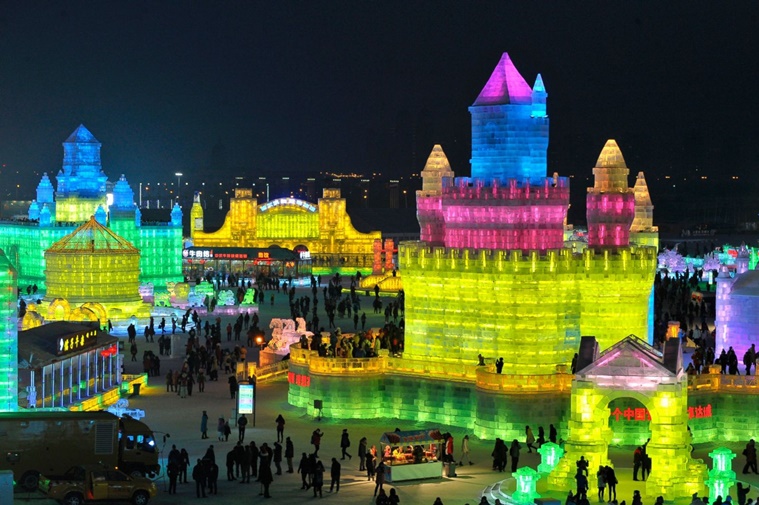Written by Abhijit Dutta |Updated: January 20, 2019 6:00:56 am
The mysterious enchantment of the annual ice festival in China’s Harbin
Come the annual festival, the frozen Chinese city of Harbin transforms into a surreal, make-believe land.

Many years later, as he faced the firing squad, Colonel Aureliano Buendia was to remember that distant afternoon when his father took him to discover ice.” With this magical line, begins Gabriel Garcia Marquez’s fantastic novel, One Hundred Years of Solitude (1967), set in the fictional town of Macondo. Ice had come to Macondo after the magnet, the telescope, the magnifying glass, the compass, the astrolabe, the sextant, and the implements of alchemy — each a fabulous marvel. Like ice, they, too, had been brought to the village by gypsies, those eternal wanderers, and they filled the inhabitants of the sweaty swampland with “the urge to discover the wonders of the world”. And ice was a wonder indeed. Confronted on that distant afternoon with the glacial exhalations of “an enormous, transparent block”, Aureliano’s father declares “this is the great invention of our time”.

What is it about ice and snow that enthralls us so? Why does water that is hard to touch evoke such excitement, putting us in a mood to play, extracting our inner child like a magician does multicoloured ribbons from his hat? Why do we — who lead sweaty, tropical lives, unaware of the depredations of cold — turn delirious in the presence of ice?
These were the questions I was left pondering as I tried to feel my face through the bitter cold. I thought about these questions as I watched others — as many grown men and women as children — queue up to seat their bottoms on slides made of ice, watched them run around in a frenzy from one frozen sculpture to the next, licking, hugging, kissing the cold blocks, fascination carved into faces immobile with cold as they walked through a whole world made from ice and snow. Here is the Roman colosseum, there the imperial palace of the Forbidden City, a row of high-rise towers, Disney castles across the bridge, and, beyond them, oriental joss houses that looked like they were fondant figurines on a cake. There are bridges and arches, slides and gateways. Ice, all of it is ice. Sparkling like diamonds by sunny day, glowing with neon hues in LED night.

I have come to Harbin — one of China’s coldest cities — to see the annual ice and snow festival. The festival, which opened on January 5 and runs till February 5, is the largest of its kind in the world and draws more than a million visitors. No one seems to mind the tundra temperatures — everyone is too busy having fun roaming the sprawling icescapes spread over an area that’s double the size of Delhi’s Lodhi Garden, tobogganing down smooth, snowy slopes, only to rush back to the top to do it all over again, cuddling snow foxes like they were pillows, riding horse-drawn sleighs lit up in bright colours. The mood is carnivalesque. I would call it madness if I wasn’t doing all of these myself. To put that in perspective — I am Bengali. My parents taught me to wear sweaters at 16 degrees Celsius and mufflers at 15. This is minus 21, 22, 25 — colder, much colder, than, say, Iceland or Greenland. (Although, here, too, climate change is catching up. Like the Arctic Circle, Harbin has recorded its warmest temperatures ever, the mercury rising on some days to -18 degrees Celsius when it really should be around -30 degrees this time of the year.

The festival occupies the whole city, one way or another. It creates more than 10,000 seasonal jobs; and for the cutters who work on the sculptures, wages can range from $35-50 for a day’s work. Shops are busy, restaurants are crowded, hotels are full — it’s mostly the mainland Chinese who flock here, but also a considerable number of Russians travel in from Vladivostok across the border, western expats with families, and a fair number of visitors from Singapore, Hong Kong and Taiwan. Scalpers, touts and guides keep up a brisk trade. There is plenty to see and plenty to do. There is the ice and snow theme park, two international sculpture competitions, a skiing festival, a winter swimming festival, a street sculpture festival (which makes the whole city pop with the icy dazzle of cute figurines basking in sunshine), and dozens of other events.
It’s all meant to be fun and games, yet, to me, it felt like a mysterious enchantment. At night, from my hotel across the frozen Songhua — the river that provides the festival with most of its building blocks — I could see the city of ice illumined in bright pinks, oranges, blues, greens and reds, arrayed in the dark, frigid night. It felt far away from the “real world”






















No hay comentarios:
Publicar un comentario